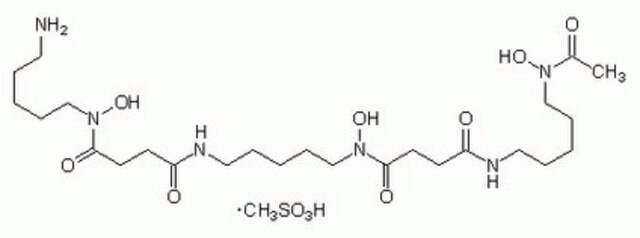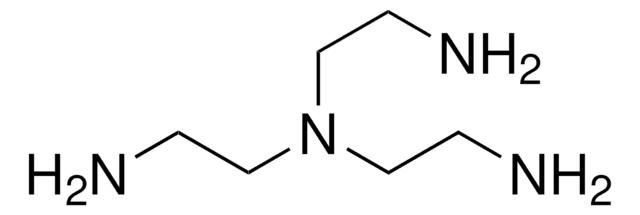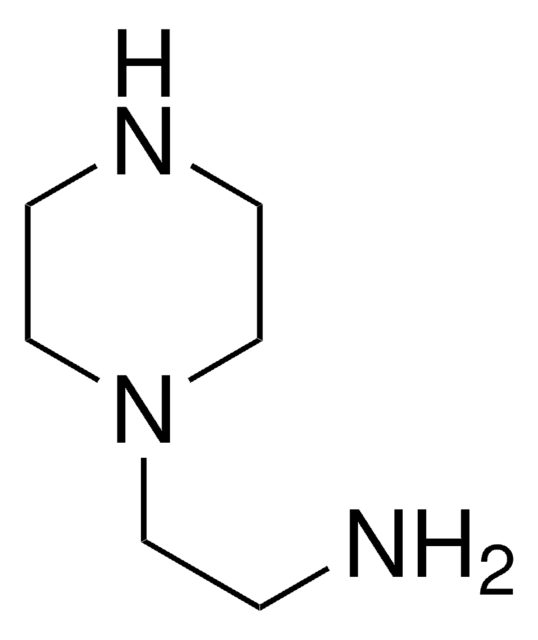161969
Triethylenetetramine tetrahydrochloride
97%
Synonym(s):
Cuprior, Trientine tetrahydrochloride
Sign Into View Organizational & Contract Pricing
All Photos(2)
About This Item
Linear Formula:
NH2CH2CH2(NHCH2CH2)2NH2 · 4HCl
CAS Number:
Molecular Weight:
292.08
EC Number:
MDL number:
UNSPSC Code:
12352100
PubChem Substance ID:
NACRES:
NA.22
Recommended Products
Assay
97%
mp
269-270 °C (lit.)
functional group
amine
SMILES string
Cl.Cl.Cl.Cl.NCCNCCNCCN
InChI
1S/C6H18N4.4ClH/c7-1-3-9-5-6-10-4-2-8;;;;/h9-10H,1-8H2;4*1H
InChI key
OKHMDSCYUWAQPT-UHFFFAOYSA-N
Related Categories
General description
Triethylenetetramine tetrahydrochloride is a copper-chelating agent
Application
Triethylenetetramine tetrahydrochloride was used as primary amine displacer in affinity chromatography.
Biochem/physiol Actions
Triethylenetetramine tetrahydrochloride induces apoptosis of acinar cells of the pancreas in male Fischer 344 rats.
Signal Word
Warning
Hazard Statements
Precautionary Statements
Hazard Classifications
Carc. 2 - Eye Irrit. 2 - Skin Irrit. 2 - STOT SE 3
Target Organs
Respiratory system
Storage Class Code
11 - Combustible Solids
WGK
WGK 3
Flash Point(F)
Not applicable
Flash Point(C)
Not applicable
Personal Protective Equipment
dust mask type N95 (US), Eyeshields, Gloves
Choose from one of the most recent versions:
Already Own This Product?
Find documentation for the products that you have recently purchased in the Document Library.
Customers Also Viewed
S Kishimoto et al.
Experimental and toxicologic pathology : official journal of the Gesellschaft fur Toxikologische Pathologie, 45(8), 489-495 (1994-04-01)
Male Fischer 344 rats weighing 80-90 g were fed on a copper-depleted diet supplemented with 0.6% triethylenetetramine tetrahydrochloride (a copper chelator), and the death of pancreatic acinar cells of these rats was investigated morphologically and biochemically. The weight of the
Structural characteristics of low-molecular-mass displacers for cation-exchange chromatography: II. Role of the stationary phase.
Shukla AA, et al.
Journal of Chromatography A, 872(2), 295-310 (1998)
Concetta R Capo et al.
Journal of trace elements in medicine and biology : organ of the Society for Minerals and Trace Elements (GMS), 44, 225-232 (2017-10-03)
The secoiridoid oleuropein is a non-flavonoid polyphenol, found in the fruit, leaves and food derivatives from Olea europea. Like other polyphenols it shows a very low toxicity towards healthy tissues and a protective action against cancer or neurodegeneration, but its
Global Trade Item Number
| SKU | GTIN |
|---|---|
| 161969-100G | |
| 161969-25G | 4061832106229 |
Our team of scientists has experience in all areas of research including Life Science, Material Science, Chemical Synthesis, Chromatography, Analytical and many others.
Contact Technical Service










